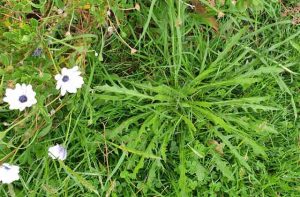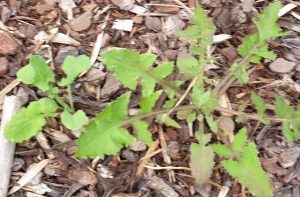Let’s find out more about why we call some plants weeds and why they are not all really bad. So that we can think usefully about removing unwanted species we need to get a full picture of their negative and, dare I say it, positive impacts.
There are many interpretations of what a weed is, dependent on, amongst other things, personal preference for plants and their particular role, use or contribution to a home, person or landscape. We thank Bridey Oliver for research and draft of this article.
What is a Weed?
“….a weed is simply a plant which in a particular place at a particular time arouses human dislike…”
William Stearn -Journal of the Royal Horticultural Society 19561.
However at the environmental and agricultural level there is less room for personal preferences as weedy plants can have serious impacts.
Various bodies have defined what a weed is. Whilst not dissimilar, they are not exactly the same.
- A weed is plant that is growing where it is not wanted2
- A plant that requires some form of action to reduce its harmful effects on the economy, the environment, human health and amenity3.
- A species that adversely affects biodiversity, the economy or society4.
A useful overview was provided in a University of Melbourne course handbook5. “Weeds are plants that grow where they are not wanted, can cause health problems in humans (hayfever, contact dermatitis etc), cause health problems in livestock, reduce the aesthetics of an area and can compete with desired plants for light, water and nutrients. A successful weed is a plant that can have high levels of seed production, seed dormancy, can propagate from other plant parts such as bulbs, rhizomes and can live a long time in the soil. Some weedy plants propagate by both seed and vegetative parts. They tend to establish quickly and can quickly occupy disturbed land areas. Many successful weeds can tolerate conditions that may be more challenging for non-weedy species. I.e, drier or wetter sites, hotter or shadier places. “
Many of our worst pest plants (weeds) are escapees from gardens. In fact, around 65% of pest plants that naturalised (became established) in Australia between 1971 and 1995 were imported as ornamental plants for gardens6. For example some of the worst weeds include plants like agapanthus and arum Lilies. Let’s not forget, though, that native Australian plants can also become weeds.
Impacts of Weeds
Bearing in mind that a plant’s classification as a weed can be quite subjective, many plants considered as weeds can also quite useful. Potential benefits or drawbacks depend on a number of factors including species of weed, the location and the needs or desires of the user.
|
POSITIVE |
NEGATIVE |
| Provide a cheap/free source of food containing high levels of vitamins and minerals if correctly chosen. | Weeds provide competition for nutrients, light, water and space and can reduce those available for the desired species. |
| Can provide food or habitat for species of fauna (eg. Bees) | Weeds can provide a breeding ground or home for a number of garden pests and diseases. |
| Important medicinal plants | In the broader environment invasive plants can displace native species, having a serious negative effect on native habitat (i.e. reducing food or nesting sites) potentially leading to extinctions. |
| Weeds, like many other plants, can give an indication of soil condition. | In Agriculture weeds can be costly, through herbicide use to reduce or remove them and through reduced yields, through injury or illness to livestock (in the case of toxic plants), or contamination |
| Some weeds are also poisonous or irritating to people |
Know your weeds
 Being able to identify the common weeds in your garden allows you to take effective action for reducing them (if you want to of course). The State of Victoria, under the Catchment and Land Protection Act 1994 has declared a number of plants as noxious weeds. This means that they are harmful or have the potential to be harmful to the environment or cause economic harm or be harmful to humans. Plants classified as noxious weeds are placed into one of four categories; State Prohibited Weeds, Regionally Prohibited Weeds, Regionally Controlled Weeds, Restricted Weeds.
Being able to identify the common weeds in your garden allows you to take effective action for reducing them (if you want to of course). The State of Victoria, under the Catchment and Land Protection Act 1994 has declared a number of plants as noxious weeds. This means that they are harmful or have the potential to be harmful to the environment or cause economic harm or be harmful to humans. Plants classified as noxious weeds are placed into one of four categories; State Prohibited Weeds, Regionally Prohibited Weeds, Regionally Controlled Weeds, Restricted Weeds.
Classification of Weeds7
|
Classification |
Description |
Example |
|
| State Prohibited Weeds | Are either not yet present in Victoria or present in very low numbers but present a significant threat if allowed to invade. The State Government of Victoria is responsible for eradicating these weeds, but may direct landowners to take action on them. | Mexican Feather Grass – Nassella tenuissima
Water Hyacinth Eichhornia crassipes |
|
| Regionally Prohibited Weeds | P | Not widely spread through a region (catchment area defined within the CaLP 1994) but have the potential to do so. They must be managed with eradication the goal. Landowners (private and public) must take all reasonable steps to eradicate these weeds on their land | Artichoke Thistle – Cynara cardunculus if prohibited in the Goulburn, North East and West Gippland Catchments. |
| Regionally Controlled Weeds | C | Usually widespread in a region. Control measures must be undertaken by landowners to prevent growth and spread of weeds on their land | Hawthorn – Crataegus monogyna in the Goulburn and Port Phillip and Western Port Catchments |
| Restricted Weeds | R | Plants that post a very high risk of spread within Victoria and also pose a threat to another state or Territory. It is prohibited to trade seeds, plants of these species. | Hawthorn – Crataegus monogyna in the Mallee, North Central, Corangamite and Glenelg Catchments |
Many local government areas (LGA) and Catchment Management Authorities provide identification resources for plants considered weeds or problem plants in the local area and management methods. These lists can usually be found online at the LGA websites or sometimes in hard copy in council offices, information stands/centres in parks and gardens. For example the Mornington Peninsula Shire Council produce a brochure that is available in hard copy and online to help identify invasive/pest plants in that area8.
Online weed databases such as Weeds Australia9 which is a website run by the Centre for Invasive Species Solutions (a research and extension partnerships between Australian Federal and State Governments, CSIRO, Government bodies and Universities).
For other sources of information relating to weeds, identification and management see our reference and resources lists at the end of this article.
Weed Categorisation
 It is possible to categorise weedy plants a number of ways; by life cycle, life form, by survival strategies, by impact, amongst others. Categorising weeds can inform the most effective way to deal with them or if removal is necessary. The two easiest, therefore most useful to most people are life cycle and life form.
It is possible to categorise weedy plants a number of ways; by life cycle, life form, by survival strategies, by impact, amongst others. Categorising weeds can inform the most effective way to deal with them or if removal is necessary. The two easiest, therefore most useful to most people are life cycle and life form.
|
LIFE CYCLE |
LIFE FORMS |
| ANNUAL – Complete their lifecycle in one growing season. They need to flower and then set seed each year in order to continue the next generation. | BROAD LEAF (DICOTYLEDON) – emerge and develop two seed leaves, flat and broad leaves and the veins resemble a spreading network and a taproot system. |
| BIENNIAL – These plants complete their lifecycle in two years. In the first year they germinate and develop leaves and in the second year they flower and set seed. | GRASSES (MONCOTYLEDON) – emerge and develop with one seed leaf, has long and narrow leaves that are characterised by parallel veins and a fibrous root system. |
| PERENNIAL – These live for many years and flower and set seed each year. Perennials may be fixed in position, generally only reproducing by seed, or spreading. Perennials which spread do so by the development of their vegetative parts including stolons, runners, rhizomes, corms, tubers, bulbs and bulbils as well as reproduction by seed. |
Of course, if you’d like to learn to identify weeds for other uses (e.g. edible weeds) there are books to assist with identification and, in most Australian states, weed walks/foraging walks with experts who show you some of the edible and easily identifiable weeds.
http://www.edibleweeds.com.au/
https://www.eatthatweed.com/
https://pfaf.org/user/Default.aspx
We are very grateful to Bridey Oliver for the research and first draft of this article and to financial support from the Lord Mayor’s Charitable Foundation.
References
- Stearn 1956. Review of Weeds by W.C. Muenscher. Journal of the Royal Horticultural Society. p285.
- Richardson, DM,Pyšek P,Carlton JT. A compendium of essential concepts and terminology in invasion ecology. Fifty years of invasion ecology. The legacy of Charles Elton (ed. by D.M. Richardson), pp. 409–420, Wiley-Blackwell, Oxford.
- Department of Environment and Water Resouces 2007. The Australian Weed Strategy. p. 21.
- Groves RH, Boden R, Lonsdale WM 2005. Jumping the Garden Fence. CSIRO Report prepared for WWF.
- University of Melbourne Burnley Lectures – 2016. NRMT20016. Plant Protection – Weed Management
- Commonwealth of Australia 2017. Australian Weeds Strategy 2017 – 2027.
- Agriculture Victoria. Invasive Plant Classifications. 2020. https://agriculture.vic.gov.au/biosecurity/weeds/invasive-plant-classifications
- https://www.mornpen.vic.gov.au/Your-Property/Environment/Flora-Fauna-Biodiversity/Environmental-Noxious-Weeds
- Weeds Australia. 2021. Centre for Invasive Species Solutions. Identify a Weed in Your Region. https://weeds.org.au/identify/
Other Useful Resources
Grubb, A Raser-Rowland A. 2012. A Weed Forager’s Handbook.
Aldous D. 1991. Weed Control for the Home Gardener. Lothian Australian Garden Series.
Herrera PJ, Dorado J, Ribeiro A.2014 A Novel Approach for Weed Type Classification Based on Shape Descriptors and a Fuzzy Decision-Making Method. Sensors14, 15304-15324.
http://www.edibleweeds.com.au/
Related Articles:
Weed Control
Several different approaches are needed for weed control since eradication is difficult and can be expensive. Preventing weeds from establishing and…
Low Impact Pest Management 101 Video
Sustainable Gardening 101 Video Series PART 3: Low Impact Pest Management Gardens are the natural habitat for all types of insects – the good, the…


